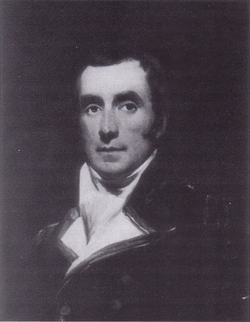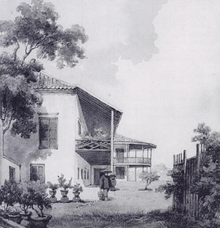William Napier, 9th Lord Napier
| The Lord Napier | |
|---|---|
 | |
| Chief Superintendent of British Trade in China | |
|
In office 31 December 1833 – 11 October 1834 | |
| Preceded by | Position created |
| Succeeded by | John Francis Davis |
| Personal details | |
| Born |
13 October 1786 Kinsale, Ireland |
| Died |
11 October 1834 Macau |
| Spouse(s) | Elizabeth Cochrane-Johnstone |
| Profession | Naval officer, trade envoy |
William John Napier, 9th Lord Napier (Chinese: 律勞卑; 13 October 1786 – 11 October 1834) was a British Royal Navy officer and trade envoy in China.
Early life
Napier was born in Kinsale, Ireland, on 13 October 1786.[1] He was the son of Francis Napier, 8th Lord Napier (1758–1823) and the father of Francis Napier, 10th Lord Napier and 1st Baron Ettrick (1819–1898). He served during the Battle of Trafalgar (1805) as a midshipman. He later served as lieutenant under Thomas Cochrane, 10th Earl of Dundonald.
Career


A peer of Scotland, Lord Napier was an elected Scottish representative in the House of Lords from 1824 to 1832. In December 1833, upon the ending of British East India Company's monopoly on trade in the Far East, he was appointed by Foreign Secretary Lord Palmerston, a family friend of Napier, as the first Chief Superintendent of Trade at Canton (now Guangzhou), in China. The Second and Third Superintendents were John Francis Davis and Sir George Best Robinson, respectively. He arrived at Macau on 15 July 1834 on board the East India Company frigate Andromanche, and reached Canton ten days later, with the mission of expanding British trade into inner China. Lacking the necessary diplomatic and commercial experience, he was not successful in achieving the objective.
Having failed to secure a meeting with Lu Kun, the Governor-general of the Liangguang,[2] and amid a litany of Chinese breaches of protocol, corrupt Chinese officials, misunderstandings approaching complete communication breakdown and stubbornness on both sides, Napier's frustration in failing to break an intractable trade deadlock and secure the rights of British traders led to his favoring a military solution. He sent the frigates Andromache and Imogene to Whampoa on 11 September,[3] defying an edict issued by Lu Kun, with fatalities resulting on both sides in a skirmish of cannon fire as the British warships breached defences at the Bocca Tigris. After a prolonged stalemate, Lord Napier was forced, sapped by typhus, to retire to Macau in September 1834, where he died of the fever on 11 October. Originally buried in Macau, he was later exhumed for reburial at Ettrick in Scotland.
Napier was the first British representative to suggest annexing Hong Kong.[1] In a dispatch to Lord Palmerston on 14 August 1834, he suggested a commercial treaty, backed by an armed force, be done to secure the rights and interests of European merchants in China. He recommended that a small British force "should take possession of the Island of Hongkong, in the eastern entrance of the Canton River, which is admirably adapted for every purpose".[4]
Lord Napier married Elizabeth Cochrane-Johnstone (c. 1795–1883), daughter of Scottish adventurer Andrew Cochrane-Johnstone, in 1816; they had two sons and five daughters. His eldest son, Francis Napier, also entered diplomatic service and was promoted by Palmerston for the rest of his life.
Honours
Following his death, the British Government placed a memorial to him before the Macao Customs Office. After being lost for a short time, it was moved to the Hong Kong Cemetery, and then to the Hong Kong Museum of History, where it now rests.
Notes
- 1 2 Laughton, J. K.. "Napier, William John, ninth Lord Napier of Merchistoun (1786–1834)". Oxford Dictionary of National Biography (2004 ed.). Oxford University Press. doi:10.1093/ref:odnb/19773.
- ↑ Hanes & Sanello 2004, p. 27.
- ↑ Lydia He. LIU; Lydia He Liu (30 June 2009). The Clash of Empires: the invention of China in modern world making. Harvard University Press. pp. 47–. ISBN 978-0-674-04029-8.
- ↑ Eitel 1895, p. 56
References
- Eitel, E. J. (1895). Europe in China: The History of Hongkong from the Beginning to the Year 1882. London: Luzac & Company.
- Hanes, W. Travis; Sanello, Frank (2004). Opium Wars: The Addiction of One Empire and the Corruption of Another. Sourcebooks. ISBN 9781402229695.
- Hoe, Susanna; Roebuck, Derek (1999). The Taking of Hong Kong: Charles and Clara Elliot in China Waters. Richmond, Surrey: Curzon Press. ISBN 0-7007-1145-7.
- Napier, Priscilla (1995). Barbarian Eye: Lord Napier in China, 1834, the Prelude to Hong Kong. London: Brassey's. ISBN 9781857531169.
- Welsh, Frank; Rao, Maya (1996). A Borrowed Place: The History of Hong Kong. ISBN 1-56836-134-3.
External links
| Wikimedia Commons has media related to William Napier, 9th Lord Napier. |
- The Napier Affair (1834)
- Another description of the Napier Affair
- Glenn Melancon, "Peaceful Intentions: The First British Trade Commission in China, 1833-5,” Historical Research 73 (2000) password required.
| Peerage of Scotland | ||
|---|---|---|
| Preceded by Francis Napier, 8th Lord Napier |
Lord Napier 1823-1834 |
Succeeded by Francis Napier, 10th Lord Napier |